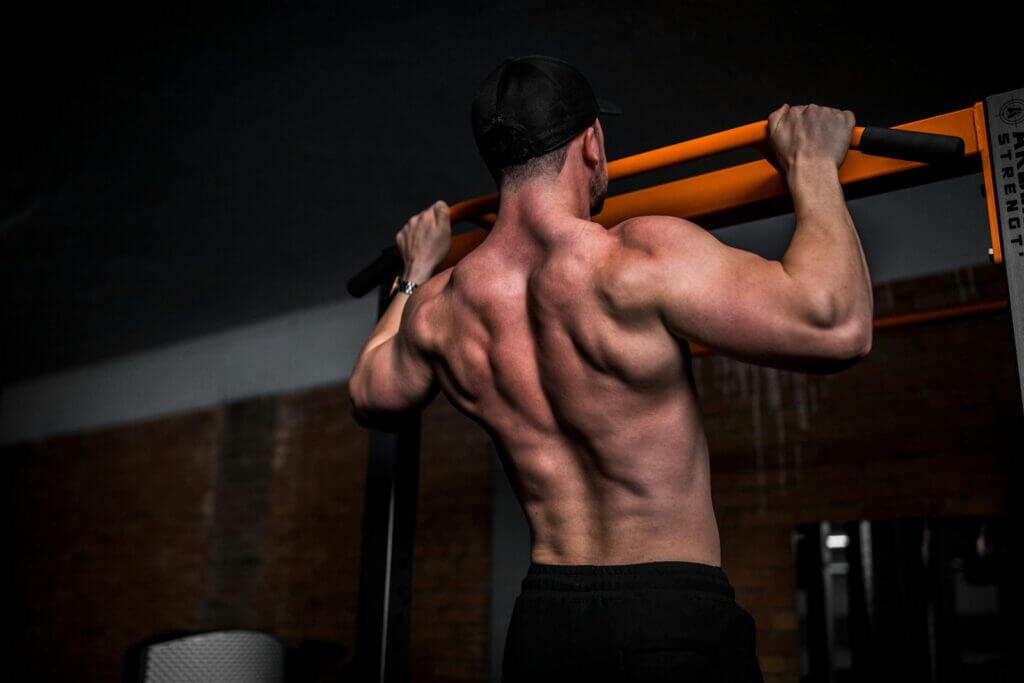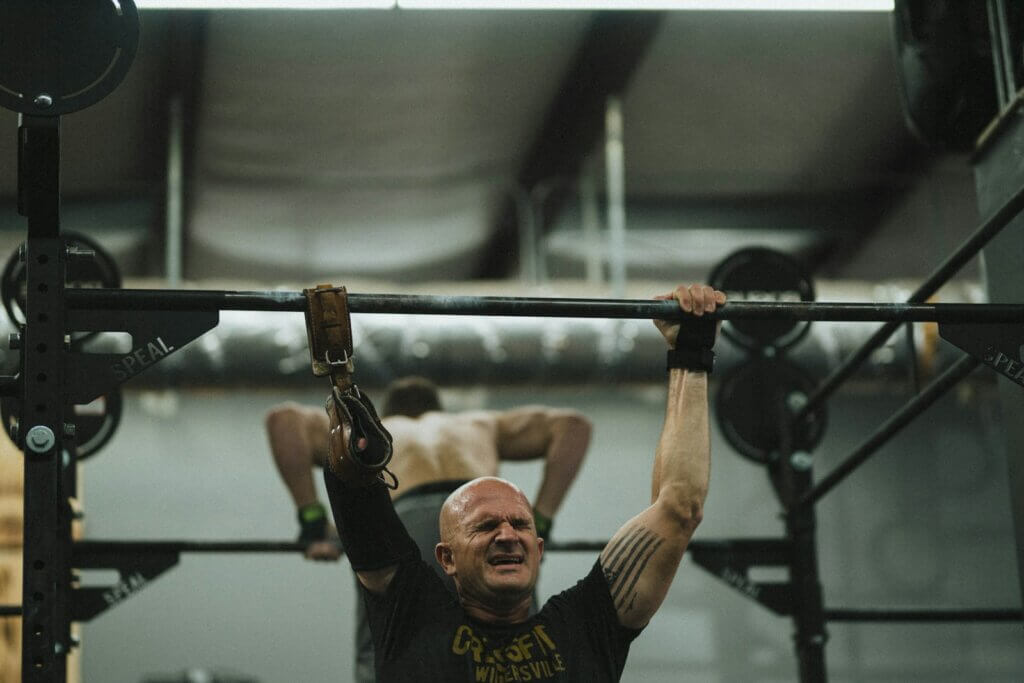How to do Chest to Bar Pull Ups (C2B)

Introduction:
Chest-to-bar pull-ups are a staple exercise in CrossFit and functional fitness training. They are a progression from the standard pull-up, requiring the athlete to pull themselves high enough to touch their chest to the bar. This movement not only enhances upper body strength but also improves grip, core stability, and overall body control. Aiming to pull your chest to the bar requires greater range of motion and strength, making it an excellent exercise for both beginners and intermediate athletes looking to challenge themselves and improve their fitness level.
Steps in the Chest to Bar movement
Setup:
- Start by gripping the pull-up bar with an overhand grip, hands slightly wider than shoulder-width apart.
- Hang from the bar with your arms fully extended and engage your core to stabilize your body.
Initiate the Pull:
- Begin the pull-up by engaging your lats and retracting your shoulder blades.
- Pull your elbows down and back, focusing on lifting your chest towards the bar.
Reach the Bar:
- Continue pulling until your chest touches the bar. Your elbows should be driving past your torso, and your chest should be out.
Lowering Phase:
- Lower yourself back down to the starting position with control, ensuring your arms are fully extended at the bottom.
- Repeat the movement for the desired number of repetitions.
What Equipment is needed
- Pull-Up Bar: A sturdy, secure bar that can support your body weight is essential.
- Chalk: Optional but recommended to improve grip, especially if your hands tend to sweat during workouts.
- Grips: Optional but recommended to improve grip.
Check out the Equipment subsite for more tools, tips, and inspiration.

Shop Crossfit gear now on Amazon
See Amazons extensive range of workout gear here. (Affiliate Link)
Performing chest-to-bar pull-ups requires more than just determination—it demands the right tools for safety and efficiency. The centerpiece of your setup is a high-quality pull-up bar. Look for one that’s not only durable but also adjustable, as having the correct height ensures you can perform the full range of motion without compromising your form. Wall-mounted or freestanding pull-up rigs are ideal for home gyms, offering stability and versatility for various exercises.
For enhanced grip and hand protection, consider investing in gymnastics grips. These provide a barrier against friction, reducing the likelihood of blisters or calluses while improving your hold on the bar. Additionally, chalk is a game-changer for maintaining a secure grip during high-rep or high-intensity sets, especially if you’re prone to sweating.
If you’re ready to elevate your performance, check out our recommended gear section for top-rated pull-up bars, grips, and chalk. Investing in reliable equipment not only improves your training experience but also minimizes the risk of injuries, allowing you to focus on perfecting your form and reaching your fitness goals. Quality tools can make all the difference in your journey to mastering chest-to-bar pull-ups.
Scaling Options:
To gradually build strength and proficiency, consider the following scaling options:
- Band-Assisted Chest-to-Bar Pull-Ups: Use a resistance band looped around the bar and your feet to provide assistance.
- Jumping Chest-to-Bar Pull-Ups: Use a small jump to help initiate the pull-up, reducing the load on your upper body.
- Ring Rows: A horizontal pulling exercise that can help build the strength needed for chest-to-bar pull-ups.
Common Mistakes to Avoid:
- Incomplete Range of Motion:
- Ensure your chest touches the bar on every rep to maximize the effectiveness of the exercise.
- Swinging:
- Engage your core and control your body to minimize swinging and maintain proper form.
- Using Only Arms:
- Engage your back muscles, especially the lats, to assist in the pull-up. This will distribute the load more effectively and prevent arm fatigue.
Mastering chest-to-bar pull-ups is a rewarding journey, but it’s easy to fall into common pitfalls along the way. One of the most frequent mistakes is neglecting the importance of a proper warm-up. Jumping straight into this demanding exercise without preparing your shoulders, wrists, and lats can lead to strain or injury. Spend a few minutes on dynamic stretches, scapular pull-ups, and mobility drills to ensure your joints are ready for action.
Another mistake is relying too heavily on momentum. While some kipping techniques can aid efficiency in high-rep scenarios, excessive swinging compromises form and reduces the exercise’s effectiveness. Focus on controlled movements, engaging your core and lats to pull your chest to the bar with precision and power.
Grip errors are also common. Holding the bar too tightly can lead to premature forearm fatigue, while an improper hand position may limit your pulling strength. Aim for a firm yet relaxed grip, with your hands slightly wider than shoulder-width apart.
Lastly, avoid neglecting progressions. Many athletes rush to perform chest-to-bar pull-ups without building a solid foundation of strength. Start with band-assisted pull-ups or strict pull-ups to develop the necessary power and control. Recognizing and correcting these mistakes early will set you up for long-term success.
Benefits of the Movement:
- Upper Body Strength: Targets the lats, biceps, and upper back muscles, enhancing overall upper body strength.
- Grip Strength: Improves grip endurance and strength, beneficial for various lifting and functional movements.
- Core Stability: Requires significant core engagement to maintain body control and stability throughout the movement.
- Functional Fitness: Mimics real-life pulling actions, making it a practical addition to any fitness routine.

Why Chest-to-Bar Pull-Ups Are a Game-Changer
Chest-to-bar pull-ups are more than just a variation of the standard pull-up—they’re a full-body workout that takes your strength and athleticism to the next level. By requiring you to pull your chest all the way to the bar, this exercise activates a broader range of muscles, including your upper back, biceps, and core, while demanding greater mobility in the shoulders. The increased range of motion not only builds strength but also enhances flexibility and control, making this exercise a must-have in your fitness routine.
For athletes, chest-to-bar pull-ups are particularly valuable because they closely mimic functional movements used in sports. The explosive pulling motion develops power, while the core engagement improves stability, both of which translate to better performance in activities like climbing, swimming, or grappling. For CrossFit enthusiasts, mastering this movement is essential for excelling in WODs and competitions, as it’s often included in benchmarks and challenges.
If you’re looking to maximize your workout efficiency, chest-to-bar pull-ups are a great choice. They build upper-body endurance, improve grip strength, and offer a cardiovascular challenge when performed in high-rep sets. Whether you’re training for strength, agility, or endurance, adding chest-to-bar pull-ups to your program is a surefire way to see results.
Which Muscles Are Worked:
During this exercise, the following muscle groups are engaged:
- Primary Muscles:
- Latissimus dorsi, biceps brachii, trapezius, and rhomboids.
- Secondary Muscles:
- Forearms, deltoids, and core stabilizers including the abdominals and obliques.
Progression Plan: From Pull-Up to Chest-to-Bar Mastery
Achieving chest-to-bar pull-ups starts with a structured progression plan that builds your strength, coordination, and confidence. Begin by mastering strict pull-ups. Aim for a consistent 8-10 reps with proper form before progressing. Strict pull-ups develop the foundation of upper-body strength needed for the chest-to-bar variation.
Next, incorporate band-assisted chest-to-bar pull-ups. Use a resistance band looped around the bar and under your knees or feet to provide additional support. This modification allows you to practice the full range of motion while reducing the load, helping you focus on technique.
Once you’re comfortable with the assisted version, start practicing explosive pulls during regular pull-ups. The goal is to pull your chest higher than your chin, gradually working towards the bar. Combine this with core exercises like hollow holds and toes-to-bar to improve the control and coordination necessary for the movement.
Finally, transition to full chest-to-bar pull-ups. Begin with smaller sets, focusing on quality over quantity. With consistency, you’ll build the strength and muscle memory required to perform multiple reps efficiently. This step-by-step approach ensures steady progress and minimizes the risk of injury.
Alternative Similar Movements:
If you’re seeking variation or targeting specific muscle groups, consider incorporating these alternative exercises:
- Standard Pull-Ups: Less range of motion compared to chest-to-bar pull-ups but still an excellent upper body exercise.
- Chin-Ups: Performed with an underhand grip, focusing more on the biceps.
- Ring Pull-Ups: Performed on gymnastics rings, adding an element of instability and requiring greater muscle engagement.
- Lat Pulldowns: A machine-based alternative that mimics the pulling motion of pull-ups, useful for building strength.
Recovery Tips for Post-Chest-to-Bar Workouts
Chest-to-bar pull-ups are a taxing exercise that places significant demand on your upper body and core. To optimize recovery and prevent soreness, it’s crucial to follow a post-workout routine tailored to your needs. Start with a cooldown session that includes light cardio, such as jogging or cycling, to gradually lower your heart rate and flush out lactic acid.
Next, prioritize stretching the muscles that were heavily engaged during the exercise. Incorporate lat stretches by reaching overhead and leaning to the side, and target your shoulders with cross-body stretches and doorframe pec stretches. These movements enhance flexibility and reduce tension in your upper body.
Foam rolling is another excellent recovery tool. Focus on rolling your lats, traps, and upper back to release knots and improve circulation. Spend at least 30 seconds on each muscle group, applying gentle, consistent pressure.
Hydration and nutrition also play a critical role in recovery. Drink plenty of water to replenish lost fluids and consume a protein-rich meal or snack to aid muscle repair. Finally, ensure you get enough rest. Quality sleep allows your body to recover and rebuild stronger for your next session. Following these recovery tips will keep you feeling strong and ready to tackle your next workout.
Q&A for Chest to bar pull ups
How to get chest to bar in pull-up?
Engage your lats and focus on driving your elbows down and back to lift your chest towards the bar. Consistent practice and strengthening your back and core muscles will help achieve this.
Are chest-to-bar pull-ups harder?
Yes, chest-to-bar pull-ups require more strength and range of motion compared to standard pull-ups, making them more challenging.
How do you engage your chest when doing pull-ups?
Engage your chest by focusing on squeezing your shoulder blades together and leading with your chest as you pull up.
Why can’t I get my chest to bar?
Difficulty in getting your chest to the bar often results from insufficient back strength or improper technique. Focus on strengthening your lats and improving your pull-up form.
What is the chest to bar rule?
The chest-to-bar rule requires that your chest makes contact with the bar for the rep to count, emphasizing a full range of motion and proper engagement of upper body muscles.
Should your chest touch the pull-up bar?
Yes, for chest-to-bar pull-ups, your chest should touch the bar to ensure full engagement and range of motion.
What is a jumping chest to bar?
A jumping chest-to-bar pull-up uses a small jump to assist in the pull-up, making it easier to reach the bar with your chest.
How do I get my bar to my chest?
Focus on a strong initial pull with your lats and keep your core engaged. Drive your elbows down and back to lift your chest to the bar.
What is the difference between chest-to-bar and pull-ups?
Chest-to-bar pull-ups require your chest to touch the bar, demanding more range of motion and strength than standard pull-ups where your chin only needs to clear the bar.
What can I do instead of chest-to-bar pull-ups?
Alternative exercises include standard pull-ups, chin-ups, ring rows, and lat pulldowns, all of which target similar muscle groups and can help build strength for chest-to-bar pull-ups.
Conclusion:
Incorporating chest-to-bar pull-ups into your training regimen will significantly enhance your upper body strength, core stability, and overall fitness level. With consistent practice and attention to form, you’ll find yourself progressing not only in this exercise but in many other aspects of your fitness journey. Remember, every repetition is a step towards mastery. So, grab that bar, pull your chest to it, and conquer your fitness goals!

🏋️ Written by: Mike Kerr
Mike is the founder of Strengthguides.com and a certified CrossFit Level 1 Trainer (CF-L1) and certified Kettlebell Instructor with over 10 years of experience in functional fitness. He specializes in developing programs that maximize performance without sacrificing mobility. Mike Kerr is passionate about making complex training methodologies comprehensible and safe for everyone.
